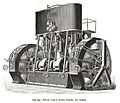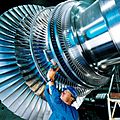Power station facts for kids
A power station (also called a power plant) is a special place where electricity is made. Most power stations have big machines called generators. These generators turn movement into electricity. They use magnets and wires to create an electric current.


In many large power stations, a machine called a steam turbine spins the generator. This steam can come from different sources:
- Burning fossil fuels like coal, oil, or natural gas.
- Nuclear power, which uses heat from radioactive materials.
- Using heat from deep inside the Earth, known as geothermal energy.
- Using heat from the sun.
Some power stations do not use steam. Instead, they use other ways to spin the generator:
- Hydropower uses the strong force of moving water, like from a river or waterfall, to turn turbines.
- Wind power uses the wind to spin large wind turbines.
- Some smaller stations use engines similar to those in cars.
A few power stations use the sun's rays directly to make solar power without any moving parts. There are many power stations all over the world because we need electricity for almost everything we do!
Contents
How Electricity is Made
Electricity is made when a generator spins. Imagine a giant spinning top that creates power! This spinning is usually done by a turbine. A turbine is like a big fan that gets pushed by steam, water, or wind.
Power from Heat
Many power stations create heat first. This heat boils water to make steam. The steam then pushes the blades of a steam turbine, making it spin very fast. This spinning turns the generator, which then makes electricity.
Sources that create heat include:
- Burning Fuels: Power stations often burn coal, oil, or natural gas. These are called fossil fuels. When they burn, they release a lot of heat.
- Nuclear Power: Nuclear power plants use a process called nuclear fission. This process splits tiny atoms and releases a huge amount of heat. This heat is then used to make steam.
- Geothermal Energy: In some places, hot rocks deep inside the Earth heat water naturally. This hot water or steam can be used to spin turbines.
- Solar Thermal Power: Some power stations use many mirrors to focus sunlight onto a central point. This creates intense heat that boils water and makes steam.
Power from Movement
Other power stations use natural movement to spin their generators directly, without needing to make steam:
- Hydro-electric Power: This is one of the oldest ways to make electricity. Water stored behind a large dam is released. As the water rushes down, it spins large turbines connected to generators.
- Wind Power: Giant wind turbines have blades that catch the wind. When the wind blows, the blades spin, turning a generator inside the turbine's tower.
- Wave Power: Some new technologies are being developed to use the up-and-down motion of ocean waves to create electricity.
- Tidal Power: This uses the natural rise and fall of ocean tides. As the tide comes in or goes out, it can push turbines to generate power.
Power Without Moving Parts
Some newer ways to make electricity do not involve spinning parts:
- Solar Cells: These are also called photovoltaic cells. They turn sunlight directly into electricity. You often see them on rooftops.
- Batteries: While not a power station, large batteries can store electricity and release it when needed.
Energy Sources We Use
The energy sources used by power stations can be divided into two main types:
Renewable Energy
Renewable energy sources can be replaced naturally and will not run out. They are often better for the environment.
- Hydro-electric power (from water)
- Wind power
- Solar power (from the sun)
- Geothermal energy (from Earth's heat)
- Wave power
- Tidal power
Non-Renewable Energy
Non-renewable energy sources are limited. Once we use them up, they are gone forever, or they take millions of years to form again.
- Coal
- Oil
- Natural gas
- Nuclear power (uses uranium, which is a limited resource)
Images for kids
-
The Athlone Power Station in Cape Town, South Africa
-
Hydroelectric power station at Gabčíkovo Dam, Slovakia
-
Hydroelectric power station at Glen Canyon Dam, Page, Arizona
-
St. Clair Power Plant, a large coal-fired generating station in Michigan, United States
-
Ikata Nuclear Power Plant, Japan
-
Nesjavellir Geothermal Power Station, Iceland
-
Cooling towers showing evaporating water at Ratcliffe-on-Soar Power Station, United Kingdom
-
"Camouflaged" natural draft wet cooling tower
-
Nellis Solar Power Plant in Nevada, United States
-
Wind turbines in Texas, United States
See also
 In Spanish: Central de generación eléctrica para niños
In Spanish: Central de generación eléctrica para niños




















